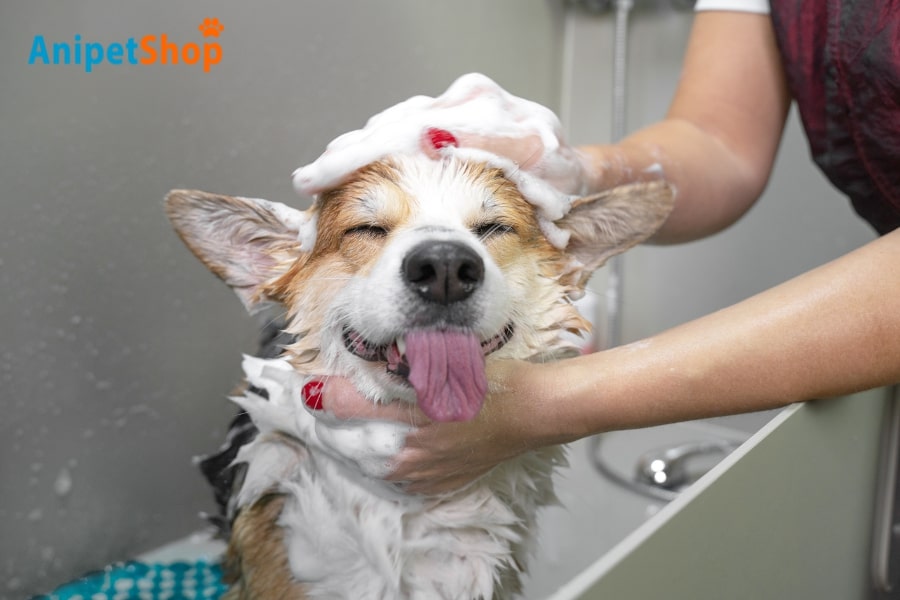How to Bathe a Dog with Ticks: A Safe and Effective Removal Guide
How to bathe a dog with ticks is crucial in the battle against these persistent parasites. While bathing alone may not remove embedded ticks, it plays a vital role in dislodging loose ones and aiding in a thorough inspection. In this guide, we will provide you with comprehensive instructions covering everything from preparing the necessary tools to bathing techniques and tick removal methods. Additionally, some important notes are proposed to ensure the most effective dog bathing process. By following these guidelines, you can ensure a safer approach to tick removal, promoting the well-being of your furry companion.

Essential Supplies for Bathing a Dog with Ticks
Before learning how to bathe a dog with ticks, you should gather these supplies to ensure a safe and effective process:
- Tick removal tool: Prepare either a pair of fine-tipped tweezers or a specifically designed tick removal tool. These tools will aid in the safe and effective removal of ticks from your dog’s skin.
- Rubbing alcohol or antiseptic wipes: Have rubbing alcohol or antiseptic wipes readily available to disinfect the bite site and any tools used during the tick removal process. This helps minimize the risk of infection.
- Gloves (optional): wearing gloves can provide an additional layer of protection and reduce the risk of disease transmission if ticks are accidentally squished during the removal process.
- Container for removed ticks: Keep a container or a sealable bag on hand to safely store any ticks that you remove.
- Dog shampoo: Make sure you have dog shampoo specifically formulated for your dog’s skin and coat type. This will help provide a thorough and effective bath, removing any dirt or debris from your dog’s fur.
- Treats for reward: Reward your dog’s cooperation during the bathing and tick removal process by having treats readily available. This positive reinforcement can help create a more pleasant experience for both you and your furry friend.

The Tick Bath Procedure
These sections below will guide you through the necessary preparations, the bathing process itself, and effective techniques for tick removal. Let’s dive into the essential steps of how to bathe a dog with ticks.
Preparation
To ensure your dog’s safety during bath time, taking a few precautions is essential. Firstly, securely leash your dog or ask someone to assist in holding them still. This prevents them from slipping away or getting anxious during the process. Secondly, select a quiet and serene area for the bath, preferably one that is easy to clean in case of any water splashes or shed fur. Lastly, it’s wise to don old clothes that you don’t mind getting wet, as bath time can sometimes be a messy affair. By following these simple steps, you can make the bathing experience more comfortable and enjoyable for both you and your furry friend.

The Bath
In the step of how to bathe a dog with ticks, start by thoroughly wetting them with lukewarm water. Make sure to wet their entire body, ensuring that the water reaches the skin. This step helps to loosen the ticks and prepare them for removal.
Next, apply a dog shampoo specifically formulated for tick removal. Work the shampoo into a rich lather, paying extra attention to areas where ticks tend to hide, such as the neck, ears, armpits, and groin. For a detailed guide on identifying these areas, refer back to our informative article on “How to Find Ticks.” Gently massage the shampoo into your dog’s fur, ensuring it reaches down to the skin where the ticks may be attached.

After lathering, thoroughly rinse your dog to remove all traces of the shampoo. While rinsing, visually inspect their coat and carefully feel for any bumps or irregularities. Ticks can often be felt as small bumps or raised areas on the skin. If you come across any ticks during this inspection, carefully remove them manually or use the tick removal tool.
Tick Removal
If you discover ticks on your dog during the bath, you should remove them carefully using the proper technique. Grasp the tick close to the skin with a pair of fine-tipped tweezers or a tick removal tool. Slowly and steadily pull the tick straight out, making sure not to twist or crush it. Avoid using bare hands and direct contact with the tick to minimize the risk of disease transmission.

After removing ticks, another important step is to disinfect the bite site. Use an antiseptic solution or a mild disinfectant. Apply it to the affected area using a clean cloth or cotton ball, ensuring thorough coverage. Disinfecting the tick bite site helps prevent infection and supports the healing process.
After the Tick Bath
After rinsing off the shampoo, thoroughly dry your dog using a clean towel or a pet dryer. Ensure that their fur is completely dry, paying extra attention to areas where ticks are prone to hide, such as the ears and paws. Moisture-free fur helps prevent the ticks from reattaching and ensures your dog’s comfort.
Once your dog is dry, perform a final and close inspection to ensure that you haven’t missed any ticks. Run your hands carefully through their fur, feeling for any bumps or irregularities. Pay close attention to areas like the neck, behind the ears, under the armpits, and around the tail. If you come across any ticks, remove them using the proper technique as mentioned earlier in this guide.
After completing the inspection, it is essential to clean the bathing area thoroughly. This step helps remove any dislodged ticks that may have fallen during the bath. Cleanse the area with a pet-friendly disinfectant or a mild detergent, ensuring all surfaces are properly cleaned. Dispose of any debris or hair in a sealed bag or trash bin to prevent further infestation.
What a Tick Bath DOESN’T Do
It is important to note that bathing alone will not effectively kill 100% embedded ticks. Some of these ticks must be manually removed from your dog’s skin. After the bath, carefully inspect your dog’s body for any ticks that may still be attached. Use fine-tipped tweezers or a tick removal tool to gently and firmly remove any embedded ticks, making sure to grasp them as close to the skin as possible. Proper tick removal is crucial to prevent any potential complications or infections.

While bathing can help in the removal of ticks, it does not provide long-term protection against future tick bites. To protect your dog from tick infestations and the potential transmission of tick-borne diseases, you can use separate tick prevention medication. For a wide range of tick prevention products, you can visit Anipet Shop, where they offer a variety of affordable preventative treatments from reputable and veterinarian-endorsed brands for pets.
When to See Your Veterinarian
In certain situations, it is best to seek professional help. Consider taking your dog to the vet if:
- You feel uncomfortable removing ticks yourself.
- You discover a significant number of embedded ticks on your dog.
- Your dog exhibits any signs of illness, such as fever, lethargy, or other concerning symptoms.

Bathing your tick-infested dog is an essential step in the fight against these persistent parasites. By mastering how to bathe a dog with ticks techniques, you can effectively reduce the tick population on your dog. Remember to use tick prevention medication in conjunction with regular bathing to protect your dog from future infestations. Visit Anipet Shop to choose appropriate products for your pets. By following these guidelines and prioritizing safety, you can effectively combat ticks and promote your furry companion’s well-being.
FAQs
What kills ticks on dogs immediately?
There are several options to kill ticks on dogs quickly. One common method is to use tick control products specifically designed for dogs, such as tick-killing sprays, spot-on treatments, or oral medications. These products contain active ingredients that effectively kill ticks on contact or within a few hours.
How do you get a tick to release?
To get a tick to release from your dog’s skin, using fine-tipped tweezers or a tick removal tool is recommended. Carefully grasp the tick as close to the skin as possible and steadily pull it straight out. Avoid twisting or crushing the tick, as this can cause it to release harmful fluids.
Can bathing a dog remove ticks? What bath solutions help?
Bathing alone may not effectively remove or kill ticks but it helps to dislodge and wash away loose ticks. You can use dog shampoos specifically formulated to repel or kill ticks as well as apply tick prevention medication alongside for comprehensive tick control.
Should dog groomers remove ticks?
Dog groomers can assist in removing ticks from dogs, but tick removal requires proper technique and caution. If a professional groomer is experienced and trained in tick removal, they may be able to safely remove ticks from your dog.
Lily Watson is an author specializing in veterinary care in Australia. With a profound passion for animal welfare and a solid foundation in veterinary science, Lily has dedicated herself to disseminating valuable knowledge and information for both pet owners and professionals in this field.

